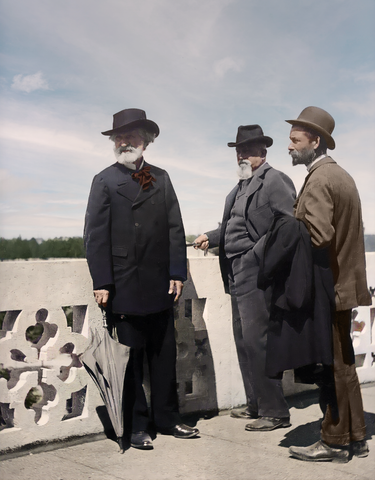Giuseppe Verdi: A Life...in Color! September 17 2021

When it comes to Italian opera, few names have had such an impact as Giuseppe Verdi (1813-1901). Considered one of the greatest composers of his generation, and probably of all times, Verdi is the author of opera classics like La Traviata, Aida, and Rigoletto, just to name a few.
On the left: Verdi in his 30s by the early 1840s
Thanks to technology, it is now possible to take a look at his life in color pictures. Through a quick glance at these photographs, one can almost feel the presence of the artist. Let’s take a look at the man behind the music.
EARLY YEARS AND ADOLESCENCE
Giuseppe Verdi was born on October 9 or 10 of 1813 in Le Roncole, a village located in northern Italy and within the border of the First French Empire during the times of Napoleon. There isn’t clarity as to the exact date he was born, although Verdi always celebrated his birth on October 9.

He came from a family of moderate means. His parents ran an inn, and by doing so, they were able to give him a formal education.
On the right: Verdi in his early 30s, around 1840s
Although Verdi used to portray himself as a self-made man who came from a humble rural background of peasant origin, he attended a school for boys in the comune of Busseto.
Young Giuseppe had shown great interest in music, learning to play the organ at an early age. Although he lived around two kilometers from home, Verdi traveled to Le Roncole every now and then to play on Sundays. This continued until he finished school.

By then, at the age of 17, Verdi had already established himself as a leader of the local Philharmonic Society of Busseto. He had built a reputation as a talented musician, so he started giving music lessons. Among his students was Margherita Barezzi, daughter of Antonio Barezzi, the director of the Philharmonic society. Margherita would later become Verdi’s first wife. Antonio would become his patron, helping Verdi move forward in the Italian music scene.
On the left: a very young maestro Verdi
FIRST OPERAS

Verdi continued to gain recognition. He worked with some of the most talented musicians in the Italian scene. However, it wasn’t all fame and glory (at least not yet).
On the right: Giuseppe Verdi by his late 50s.
In the following years, his wife Margherita and his children died due to different causes. Additionally, his work was not well received. This devastated Verdi to the point that he said he would never write any more operas. Luckily, Bartolomeo Merelli, a businessman and the librettist for Teatro La Scala at Milan where Verdi presented Oberto, convinced him otherwise.

Soon after, his works started becoming popular among opera circuits worldwide. By the 1840s, his works had already reached some of the most important cities throughout continental Europe, and they were even being presented in the Americas. Cities like New York and Buenos Aires were delighted with his works.
On the left: Verdi shown at work by the early 1840s
FAME
Verdi worked incessantly during the following years. Professionally, this was a period of intense creative outburst, having both successes and failures. In his personal life, he got married again. His new partner was Giuseppina Strepponi, an Italian operatic soprano who participated as a cast member in Verdi’s Nabucco in the Teatro Regio di Parma.

Sometime after that, Verdi worked on I Lombardi, an opera that convinced everyone that he was one of the big ones. To many experts, this is the turning point of his career. From here, success came quickly, taking him to new heights.
On the right: Verdi in his 50s.
Some of Verdi’s most iconic works come from this period, one that is not only marked by public acclaim but also by politics. Verdi started getting more involved with political matters, particularly in relation to the Risorgimento movement that sought to unify Italy under one kingdom. This brought him many problems due to attempts to censor his work. Nonetheless, he never seemed to break.

Maestro Verdi in 1892

During this period, he composed some of his major works like Aida and his Requiem. This last was thought by many to be his last great work, but Verdi surprised everyone in 1887 with another opera that would become one of his most important and acclaimed opera works: Otello. After Aida, presented in 1871, Verdi had not composed another opera.
On the left: Verdi in his sixties
FINAL YEARS

Maestro Verdi in his sixties

Otello was a success acclaimed by critics and the public alike.
On the right: Maestro Verdi and fellow composer Arrigo Boito at Verdi's Villa in Sant'Agata
After this, he worked on several other works like Falstaff and his Four Sacred Pieces. The former received a widespread reception from people all over Italy. However, some years after having finished his Four Sacred Pieces, in 1901, Verdi suffered a stroke, dying at the age of 87.

Verdi in his villa at Sant'Agata, by the 1890s
At the height of his career, he was acclaimed as Italy’s greatest opera composer.

Verdi with family and friends: Teresa Stolz standing on the left, Giuseppina Strepponi on Verdi´s right, and next to his adopted daughter Maria Carrara Verdi (light blue dress). On the right are publisher Giulio Ricordi and his wife Giuditta Ricordi, over the far right is painter Roberto Metlicovitz
VERDI PICTURES IN COLOR

When one looks at pictures of Verdi, his figure stands out as imposing, with a strong gaze, almost nostalgic at times, but above all, firm and decisive. A true man of the arts.
On the right: Maestro Verdi in his 80s at Sant'Agata
Politically and personally of a complex character, Verdi was a very private man. Like a true artist, he was solely dedicated to his work.

Verdi at the Caffé-Restaurant at the top of the Funicular (Montecatini, 1899) next to conductor Leopoldo Mugnone (left) and Teresa Stolz on his other side; soprano Giuseppina Pasaque (far left)

Looking at Verdi’s pictures in colors is a powerful experience that almost resembles hearing his work. One can’t help but feel an aura of grandeur and creativity, almost as if it were possible to be inspired just by looking at them. For the true connoisseur of his work, such a collector’s item is not only a rarity. It is a true gem of one of the most talented and creative minds the world has given.
On the left: Giuseppe Verdi in his late 80s, circa 1897

Comparison: how this was made. Artificial intelligence and artistry combined allowed to colorize this picture, bringing them to life!.
SEE ALSO:
- Verdi, Giuseppe - Signed Photograph with Francesco Tamagno
- Verdi, Giuseppe - Signed Personal Card
- Verdi, Giuseppe - Autograph Letter Signed 1852
- Verdi, Giuseppe - Boito, Arrigo - Large Vintage Print
- Verdi, Giuseppe - Signed Cabinet Photo inscribed to Blanche Marchesi 1892
- Verdi, Giuseppe - Autograph Letter Fragment 1899 + Autograph Letter by Niece Maria
- Alzira, Opera by Verdi - World Premiere Program-Libretto 1845
RELATED BLOG ARTICLES:
- Giuseppina Strepponi: The Real Traviata
- Louis Moreau Gottschalk: The First Great American Composer
- Havergal Brian: Working-Class Genius Composer
- Hugo Wolf: The Great Austrian Composer of Songs
- The Life of Chopin by Franz Liszt: An Overview
- Jacques Offenbach: Pioneer of the Operetta
- Cecile Chaminade: French Composer and Pianist
- Alberto Ginastera: A Life In Music
- Paul Dukas: The Great French Composer and a Critic
Interested in authentic autographs?


